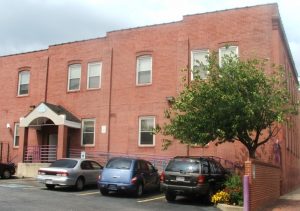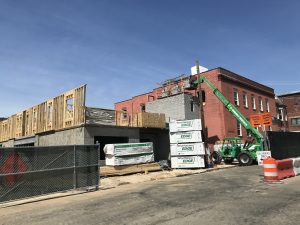Posted on July 11, 2018
Richmond Biz Sense covered the ongoing renovation at New Clay House. The project will nearly double the number of units in the building and involve much-needed improvements to each unit.
Posted on July 3, 2018


Virginia Supportive Housing has been making homelessness history for 30 years now. Doors opened at the first VSH multi-unit property back in 1992. That was New Clay House, situated at the corner of W Clay Street and N. Harrison Street. Originally, there were 47 single-resident units with shared shower and kitchen facilities. Although the model wasn’t perfect, New Clay House contributed to the incredible success rate Virginia Supportive Housing achieved; in the Richmond area, 98% of the formerly homeless individuals housed by VSH did not return to homelessness.
But experience demonstrated improvements could be made. New Clay House was good, but it was not ideal. Other properties in Hampton Roads, Richmond, and Charlottesville showed fully-furnished individual studio apartments could solve the problem of homelessness better. Think of it as the difference between a lonely college dorm room and a home of one’s own.
Thirty years in, and Virginia Supportive Housing now manages 16 multi-unit properties across the state, and the time has come for New Clay House to be upgraded. Although New Clay House was how Virginia Supportive Housing first introduced the model of permanent housing with supportive services as an answer to the problem of homelessness in Virginia, the age of the property did not reflect the standard the organization had come to uphold across all other properties. As a result, Virginia Supportive Housing has undertaken an approximately $18 million dollar project to renovate New Clay House into the new New Clay House.
Not only will the 47 pre-existing units double in size, there will be an additional 33 studio apartments for a total of 80 formerly homeless individuals off the streets. Every apartment will have a kitchenette with full-sized appliances and also a full bathroom. Residents will have a community room, a private courtyard, a computer room, a phone room, a fitness room, laundry facilities, and structured parking. VSH property management and services staff can expect their own office space also, and a large donation bay is in the works as well.
Construction started in January of 2018 and is progressing rapidly. The expected completion date is in early 2019.
Posted on July 13, 2010
I have asked Alison Jones-Nassar, VSH’s volunteer program coordinator, to write this week’s blog. Thanks, Alice
Did you know…that the problem of homelessness manifests itself differently in different countries, but that responses to it reflect universal themes?
According to Wikipedia, there are about 100 million homeless people worldwide. About 3,000,000 people are estimated to be homeless in the European Union, while in Canada that figure is about 150,000. In Australia the official figure is 105,000 and in Japan, between 20,000 – 100,000 people are identified as homeless. In so-called Third World countries, homelessness is rapidly rising due to a variety of factors including poverty, poor urban housing conditions, migration trends, overpopulation, food scarcity, and conflict. Based on available data, one thing seems to be true: homelessness looks very different from one country, region, and continent to the next.
Last week, I had the opportunity to explore this idea when I was asked to participate in a training session for a group of VCU students who are doing a summer social media project in partnership with several Richmond area non-profits. The group consists primarily of Iraqi exchange students (including Kurds), but there are also students from South America and Central Europe.

Among other things, these students are tasked with teaching basic computer and social media skills in a volunteer capacity to residents of Carver district, including some of our tenants from New Clay House. As volunteer program coordinator for Virginia Supportive Housing, it’s my job to prepare these students for interacting one-on-one with our clients, and my training was designed to help these volunteers understand how their knowledge, perceptions, awareness, and sensitivity toward the issue of homelessness could impact their experiences.
Despite the early hour (training began at 8:30 a.m.) the students quickly developed an intense interest in the subject and a lively discussion followed. Coincidentally, one student had already had an encounter with homelessness. In a blog describing her experiences in the US, she wrote about “something negative [that] happened to us that really scared us. We saw a drunk, homeless man, who asked us for money. When we ignored him, he got mad and tried to hurt us. It made us all wonder about the safety in the United States.”
Using this observation to stimulate conversation, I asked them: what is the situation like in your country? What has your exposure been to homeless people there? Why do you think people become homeless there? Why do you think they become homeless here? Do you feel toward the homeless in your country what you felt toward this man?
These questions go way beyond objective understanding to penetrate deeply ingrained value systems regarding personal fault and social obligation, political justice and divine retribution. I won’t pretend to think that I changed anyone’s perspective on the issue, though I do believe it was a very thought-provoking hour and a half for everyone in the room. One thing seems to be universal: people experiencing homelessness are invisible everywhere. People all over the world avert their gazes from the problem and try to pretend it simply doesn’t exist. They shake their heads and pass judgment and are confident it will never happen to them. We can develop our plans and strategies and goals and timelines, but there is still a lot of work to be done where it counts – in the human heart.
Posted on May 18, 2010
I have asked Heather Williams, VSH’s spring semester PR intern, to write this week’s blog. Thanks, Alice
A few months ago I became the PR intern here at VSH. When I started my position, I quickly realized I knew less than I thought I knew about the crisis of homelessness. I knew that I had compassion for people I had seen on the streets since I started my college career at VCU. I knew from my friends working on their social work degrees that many people experiencing homelessness had mental health and/or addiction problems. I knew that there had to be a solution and that I wanted to help. VSH has allowed me to do just that.
My job at VSH has included writing the “Did You Know” blogs, gathering and writing Stories of Hope and putting together the newsletter. In the past three months, I have learned more about homelessness than I ever thought I could.
I must admit that my very favorite part of my job was interviewing VSH clients who were previously homeless for the Stories of Hope. Hearing their life experiences and world views was a rare opportunity and one which I will never, ever forget. It was an unbelievable feeling to know that, through my interpretation and writing, the public would hear a story that otherwise may have never been told.
The first VSH client I interviewed was a woman a year older than me who had five children. As I asked her about her life, three of her children played in the living room. She had been homeless for years, walking and living on the streets of Richmond with her children. I will never forget the point in the interview when tears streamed down her face and then mine as well. I could barely tell my Public Relations class about the interview without choking up. No one else had an internship like mine.
In order to collect Stories of Hope, I organized and conducted two interview sessions at New Clay House. I interviewed between five and seven clients during a two hour time period. At the end of one of the sessions, it began to storm severely outside. As I am extremely frightened by thunderstorms, and this was a bad one, I could not push myself to walk to my car in the rain and lightening.
One of the clients, Terry, stood outside of New Clay House with me for more than thirty minutes while I waited for the storm to pass. We talked the entire time. He talked about his son and grandchildren living in Colorado. He asked me about my upcoming graduation and wedding. He then walked me to my car claiming that because of his height, lightening would strike him before me. We laughed the whole twenty feet we walked to my car.
Terry is one of many VSH clients I will never forget. I can’t quite express how moved I have been by the number of lives VSH has touched and changed forever. I consider myself to be one of them.
By mid-May, my internship at VSH will come to an end. I will no longer be required to write “Did You Know” or Story of Hope blog entries. Instead I will use what I do now know and my experience with clients to continue to make the argument for supportive housing. Instead of just having compassion for the homeless, I feel like I am now armed with much more useful facts and experience. Every time I hear someone complain about their “tax payer dollars” going towards people who “just choose not to work”, I will know what to tell them … the truth and the solution.
Posted on April 27, 2010
Born and raised in Richmond, Va., Anna Ray began her adult life as a waitress, single mother of three and victim of an abusive relationship. Overwhelmed by work and physical abuse, Anna lost custody of her children.
“I lost my mind and my income” Anna said.
Without any income, Anna was quickly forced to live on the streets. She slept at bus stops, abandoned buildings, balconies and friends’ houses. Anna recalls feeling very vulnerable as a woman.
Abusive relationships and gang rapes are just two of the many traumatic events Anna Ray* endured during her life on the streets.
Although it’s very difficult for her to talk about it, she goes into detail about how she was forced to trade sex for shelter. Anna recalls one instance when she slept with a man for shelter. That particular night he returned with a group of his friends who proceeded to take turns raping her.
During the days, Anna did temp work to get money for food. She said she would beg for food when she had to but never money as she feels it’s degrading.
Anna tried to get back on her feet financially by staying at a local shelter but said it was difficult to get temp work that was compatible with their (the shelter’s) rules and schedule.
She finally found hope when she spoke with a friend who was staying at New Clay House. Ready to do anything to get off of the streets, Anna contacted VSH immediately.
“VSH gave me a chance when no one else would,” said Anna.
Anna moved into New Clay House (NCH) soon after she contacted VSH. She said NCH finally gave her a place to go home to, a place that is hers and most of all, a place where she feels safe.
Anna feels like she now has the support she needs to lead a fulfilling life. Staff are there for emotional support and to help her obtain needed medications.
When asked what others should know about people experiencing homelessness Anna replied, “If you see a homeless person, help them out. Buy them food or at least treat them like they are human; smile and say ‘Hi’.”
*Name has been changed to protect program participant’s identity.





